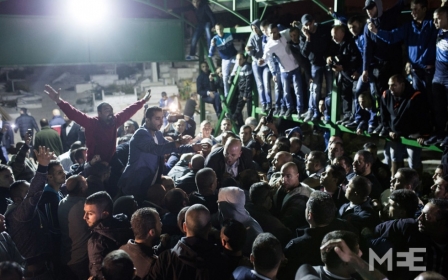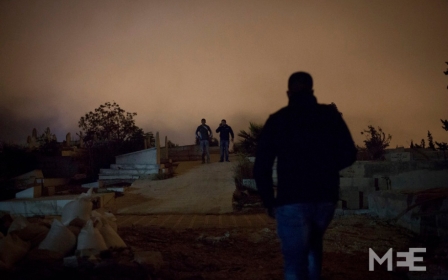Al-Aqsa reopens for worship as clashes rock West Bank

Hundreds of protesters in the Occupied Palestinian Territories of the West Bank and Gaza and parts of Jerusalem have demonstrated in support of al-Aqsa today after the compound’s temporary closure by Israel yesterday, and the killing of a Palestinian man suspected of injuring an Israeli settler.
Protesters at the Qalandiya checkpoint that separates the West Bank from Jerusaelm were fired at by Israeli officers with tear gas and rubber bullets leaving at least eight people injured, according to Middle East Eye’s reporter on the ground Fadi Arouri. One of the demonstrators, Mohamed Khatib, 26, was injured with live ammunition. Medical sources say his condition is stable. Other protesters sustained facial injuries from being fired at by rubber bullets and tear gas canisters. One demonstrator lost his eye. Protesters responded by firing Molotov cocktails at a military tower.
The demonstrators had left from the Qalandiya refugee camp in the West Bank and headed towards the checkpoint holding signs reading “at your service al-Aqsa”.
Small-scale demonstrations and clashes have broken out across other parts of the West Bank. About 200 protesters clashed with Israeli soldiers in the village of Silwad, east of Ramallah, a week after a 15-year-old Palestinian child was killed by Israeli officers there. Five people are reported to be injured after inhaling tear gas. In Hebron, one protester was injured after being hit on the head by a tear gas canister. Protesters have also blocked off a road used by settlers near Bethlehem.
In Jerusalem, Israel deployed a heavy number of police officers in anticipation of demonstrations and clashes after Friday prayers at Al-Aqsa mosque, where men under the age of 50 have been prevented from entering. The mourning period for the death of Mutaz Hijazi, the 32-year old Palestinian killed by Israeli police, will take place for the next two days. Clashes broke out in Thawri, the east Jerusalem neighbourhood where Hijazi was killed.
Thousands of Islamic Jihad supporters also marched through Gaza today.
The al-Aqsa mosque compound re-opened early on Friday for dawn prayers, and is expected to stay open throughout the day, Israeli authorities said.
The re-opening comes after a highly-controversial move on Thursday, which saw all visitors and worshippers banned from entering the site for the first time since a temporary closure of a few hours in 2000, in a move dubbed "a declaration of war” by Palestinian President Mahmoud Abbas.
Mass restrictions on entry remain in place with Muslim men under the age of 50 still prohibited from entering – an extension of an earlier restriction that has been in place on-and-off for years.
Police presence in the city has also been beefed up, with local media reporting the presence of some 3,000 officers, three times more than usual, as tensions continued to reverberate following two high-profile shootings.
On Wednesday, prominent right-wing Israeli activist and settler Yehuda Glick was shot four times at close range in Jerusalem by a gunman on a motorcycle. Israeli police subsequently shot dead the alleged gunman, Hijazi, a Palestinian from East Jerusalem, who was said to be unarmed at the time.
“They have been forced to open the gates because al-Aqsa is for the Muslims not the Jews. It is unjust for the Muslims. Today, al-Aqsa is open, but only for people at the age of 50 and over,” Ekrima Sabri, the Imam of al-Aqsa, told Middle East Eye.
“Only about 100 worshippers above the age of 50 entered the mosque for the morning prayers. We will see what will happen for the Friday prayers.”
Israeli authorities insist that the closure was enacted purely for security concerns, following Glick's shooting.
According to Israeli newspaper Haaretz, Palestine’s Fatah movement has called for a Day of Rage to take place in Jerusalem following Friday prayers. Further protests are also expected to take place in the West Bank, although bad weather, which has engulfed much of Israel and the occupied Palestinian territories, may be dampening hopes for a large turnout, MEE’s contributors on the ground have warned.
The funeral for Hijazi was held close to midnight on Thursday evening. Israeli forces had restricted attendance to 45, but hundreds of mourners snuck in over fences and through barriers to join the funeral procession.
The funeral advanced without any major incidences of violence, despite high emotions and heavy police presence. During the procession, Hijazi's brother urged for calm.
“I have already lost my brother,” he told the crowd, while stressing that more violence would likely create more trauma.
But tensions over ramped up Israeli settlement expansion in occupied East Jerusalem and the al-Aqsa restrictions remain palpable on the ground.
"At 3:00 am, the soldiers come into the camp, impose a curfew, search the area, and then break and enter [into the houses of their targets],” said Hisham, a young Palestinian from the Shuafat refugee camp in Occupied East Jerusalem.
"We're used to it. All the young people go in and out of prison on a regular basis."
Twenty-year-old Mohammed, who has just spent four months in prison, also told AFP that he planned to protest the occupation.
"There's no peace in Jerusalem. It's an intifada," he said.
"I'm ready to go back and confront the Israeli soldiers. I can't bear seeing [Jewish] settlers on the [al-Aqsa] mosque compound, when Muslims aren't allowed in."
Glick, who lives in the Jewish Orthodox Otniel settelement, is part of a growing right-wing movement in Israel that seeks to secure access and prayer rights for Jews on al-Aqsa, known to Jews as Temple Mount. He was well known for his repeated incursions into the al-Aqsa mosque and his attempts to pray there and was arrested repeatedly by Israeli police.
Sacred to both Jews and Muslims, the flashpoint al-Aqsa compound houses Islam's third holiest site, but is also revered as the most sacred spot for Jews, who refer to the site as the Temple Mount, due to the fact it once housed two Jewish temples.
Although non-Muslims are allowed to visit the site, Jews are not allowed to pray there. Rumours that Israel was poised to legislate changes to the status quo have triggered weeks of unrest and clashes in and around the plaza.
In September 2000, a visit to the site by controversial Israeli politician Ariel Sharon sparked what later became known as the "Second Intifada" – a popular uprising against the Israeli occupation in which thousands of Palestinians were killed.
The so-called Temple Mount movement - of which Glick is a member - is closely tied to the right-wing of the ruling Likud Party and has strong links with settler groups and organisations.
While Israeli Prime Minister Benjamin Netanyahu publically endorses keeping the status-quo in Jerusalem’s holy sites, the once fringe Temple Mount movement has been growing in influence in recent years and has been described by Israeli daily Haaretz as a key party of the “growing right-wing religious radicalism” in Israel.
"The demands that have been made recently over the past decade or so by the extremist Israelis, and settlers in particular, is unfounded historically including through the Jewish faith," said Friends of al-Aqsa head Ismail Patel.
"They have never requested this over the past 1000 years and it’s something new in order to provoke the Palestinians in the Muslim world."
Middle East Eye propose une couverture et une analyse indépendantes et incomparables du Moyen-Orient, de l’Afrique du Nord et d’autres régions du monde. Pour en savoir plus sur la reprise de ce contenu et les frais qui s’appliquent, veuillez remplir ce formulaire [en anglais]. Pour en savoir plus sur MEE, cliquez ici [en anglais].



